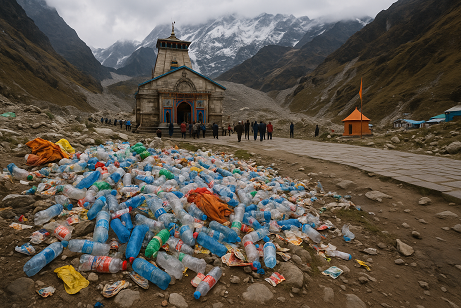By – Mohit Bangari
20 July 2025

Explore Himalaya With Me!!

Tourism in the Himalayas is booming. But at what cost?
Spiritual sites like Kedarnath and Yamunotri, which were once peaceful dhams nestled in nature’s lap, are now facing a serious threat — waste and plastic pollution. Crores of pilgrims and tourists visit these sacred spots every year, but with them comes a huge trail of plastic wrappers, empty water bottles, food waste, and discarded clothes.
In this article, I’ll take you deep into the ground reality of these two famous Char Dham sites and explain how tourism is hurting the very soul of these divine places.
Before we discuss the problem, let’s understand the importance of these places:
Kedarnath is one of the twelve Jyotirlingas of Lord Shiva, located at 11,755 ft. in Rudraprayag district. It’s not just a temple, but a living symbol of Himalayan devotion.
Yamunotri, in Uttarkashi district, is the source of river Yamuna and the first stop in the Char Dham yatra. The temple is dedicated to Goddess Yamuna.
These are not picnic spots. They are ancient spiritual routes, followed by saints, rishis, and sadhus since thousands of years. But now, the modern form of tourism has started taking over their spiritual identity.
Let’s break it down:
Every day during yatra season, thousands of pilgrims carry plastic water bottles, food packets, and other single-use items. Most of this trash doesn’t get carried back — it ends up on trekking paths, riversides, and even near temples.
In Kedarnath, during the peak season, 20-25 tonnes of waste is generated per day, according to district officials.
Yamunotri, despite being smaller, faces similar issues — especially on the trek route from Janki Chatti to Yamunotri temple. Most shops give items in plastic bags, even though plastic is banned.
Though the government and NGOs are trying, they are not able to handle the volume of garbage being produced.
In Kedarnath, the shallow soil and cold temperatures make composting slow and difficult.
Lack of enough dustbins and cleaning staff adds to the problem.
There is no waste segregation, so even recyclable materials go to waste.
In 2023, there was an attempt to carry plastic bottles down via mules, but the system collapsed due to overload.
Trash thrown near riverbanks ends up in the Mandakini (Kedarnath) and Yamuna (Yamunotri) rivers. These rivers are not ordinary streams — they are lifelines for North India. The pollution not only affects the water quality but also disrespects the holiness of these rivers.
Due to the sudden tourist rush, toilets are built quickly, often without proper sewage treatment. This results in human waste leaking into the soil and rivers.
This pollution is not just an environmental issue — it’s a spiritual insult.
Imagine — a pilgrim coming to worship Shiva at Kedarnath, steps over discarded food packets and plastic bottles on the way. The mental peace and purity one expects in such a divine place gets shattered.
Locals and priests have reported feeling hurt and angry. Many say that spiritual energy is getting disturbed due to over-commercialisation.
No, tourism brings livelihood. Local mule owners, porters, dhaba owners, and hotels earn their income through yatris.
But the problem is uncontrolled and unresponsible tourism.
Increased footfall without sustainable planning is leading to long-term damage. The purpose of pilgrimage — simplicity and purity — is being lost.
Some good steps have been taken:
Plastic ban in Uttarakhand’s sensitive zones (but poorly enforced).
Swachh Kedarnath Abhiyan by volunteers and Army units.
Installation of plastic bottle crushing machines.
NGOs like Waste Warriors working in Yamunotri and other regions.
But all this is too small compared to the scale of the problem.
To protect Kedarnath and Yamunotri, we need massive reforms and community awareness:
Even one person caught with plastic should be fined. Shops must be monitored regularly.
Limit the number of visitors per day like Vaishno Devi and Amarnath yatras. Encourage people to carry cloth bags, refillable water bottles, and bring back their own waste.
Install eco-friendly toilets and provide proper training to local staff.
Let villagers take charge of protecting their dhams. Offer incentives for cleanliness.
Use temples, gurukuls, and priests to spread the message that “Swachhta is Bhakti” (cleanliness is devotion).
I spoke to a local porter from Gaurikund. He said,
“Pehle log mitti mein pair rakhte the, ab plastic mein bhagwan ke darshan karne aate hain.”
Another sadhu from Yamunotri told me,
“Jab tak yatra business ban gaya, tab se pavitrata gayi.”
These voices reflect the pain of the land.
Kedarnath and Yamunotri are not just travel destinations. They are energy centres of Bharat’s spiritual heritage. We must act now to preserve their purity, before they turn into polluted tourist traps.
If we really want blessings from the Himalayas, we must treat them with respect — not just with prayers, but with action.
🔗 Also read:
You can also explore more on Himalayan treks like Darma Valley, Adi Kailash, and others on my website mohitbangari.com, where I share full guides, routes, permit tips and cultural info.
By – Mohit Bangari
20 July 2025
Do you know about Ramman festival of Salud-Dungra village? It’s one of the intangible world cultural heritage of India in UNESCO. You can read a detailed article on this topic here.


Explore Himalaya With Me!!
4 thoughts on “Is Tourism Hurting Spiritual Sites? Trash Problem at Kedarnath & Yamunotri”
Really important insights! Responsible tourism to spiritual sites like Kedarnath and Yamunotri is a must. For eco-friendly group travel from NCR, I highly recommend using a Tempo Traveller on Rent in Gurgaon – it’s practical and reduces individual vehicle use.
Thanks for reading this. This is really a serious issue on these destinations.
The hyperlinks to –
a) Kedarnath Yatra Detailed Guide
b) Madmaheshwar Trek – A Spiritual Journey
are not working, please fix those.
Thanks for your article. Though I want to visit the shrine but the apathy with which we keep our spiritual places reflects only hypocrisy.
Best Regards
Thnakyou Mr. Anil Khanna
I have resolved mentioned issue by you. I am great full that you point it out. Thanks.